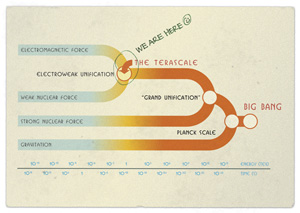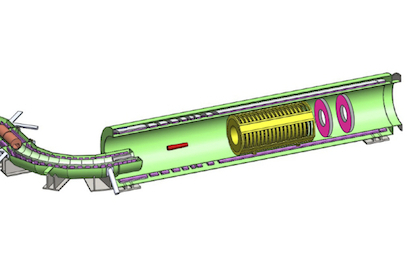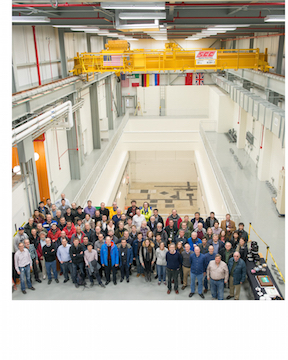Research Goals
Mu2e could advance the indirect search for new physics and the direct search for charged-lepton conversion as well as complement research done at the LHC.
The Mu2e experiment is looking for evidence that a muon can change into an electron and nothing else. Observing muon-to-electron conversion would be a major discovery and would signal the existence of new particles or new forces of nature. Mu2e can search for this new physics at energy scales far beyond the reach of the LHC — up to the energy scale of 10,000 trillion electronvolts, or 10,000 TeV. The LHC has an energy goal of 14 TeV. Mu2e conversion could give the next generation of colliders an indication of the most promising, discovery-laden energy ranges to search.
At lower energy scales, if the LHC finds new particles, it may have a difficult time distinguishing how these particles originated without the help of Mu2e. There exist many theories that address shortcomingsin our current understanding of sub-atomic particle physics. For example supersymmetric theories postulate a whole new class of particles, extra dimension theories postulate new space-time dimensions, while other theories include new forces. The observation of muons morphing into electrons would help narrow the number of plausible theories. Such an observation would give context and insight to the results of the LHC.
If Mu2e physicists get a "zero" result, meaning they don't observe muons changing into electrons, it will cast doubt on many of the existing theory models. Physicists would have to rethink their ideas about how the forces of nature unify at higher energies, as they believe happened at the time of the Big Bang.
With an upgrade, using an improved accelerator, Mu2e could expand its search for charged lepton conversion and other new physics by another one or two orders of magnitude.
Observing muon-to-electron conversion is central to understanding what physics lies beyond the Standard Model.
Physicists already have discovered that two of the three categories of elementary particles — neutrinos and quarks — change into different particles, a process called flavor violation. Proving the same process in this third particle category, charged leptons, which includes muons, remains a hurdle to understanding why particles in the same family decay from heavy to lighter mass states. Physicists have searched for this since the 1940s. Going beyond the Standard Model will help scientists unify the forces of nature, which dictate how particles interact. This unification is key to explaining how the universe changed from being dominated by the energy and radiation left over from the Big Bang to include visible matter, such as people and plants.
Muons are a heavier cousin of the electron — about 200 times more massive — but physicists are not clear how the relationship between electrons and muons works. Observing muon-to-electron conversion can help clarify how particles created at the beginning of the universe broke down into stable lighter particles. Understanding this relationship will help physicists learn more about the particles themselves and the forces that govern their interaction.
| Further reading: | |
|---|---|

|
Particle accelerators allow physicists to look farther and farther back in time, to revisit the high energies of the early universe after the Big Bang.
Do the four forces that dictate the interactions of particles that we observe today - the gravitational, electromagnetic, weak and strong forces -
converge to a single unified force at ultra-high energy? The Mu2e experiment may provide the first evidence for such unification of forces. (Click image for larger version) |

|
A real muon-to-electron conversion event will show-up in the Mu2e detector as an electron and nothing else (left).
This is a very distinctive experimental signature, however, there are mundane physics processes that can
mimic this signiature from time-to-time. Almost half of the muons that stop in the Mu2e detector will decay while in orbit
around the aluminum atoms in the stopping target. Most of the decays-in-orbit will look
like typical muon decays (center) where the electron has a maximum energy of 52.8 MeV. The Mu2e detector has been designed to be
insensitive to these decays. However, occasionally the electron can get an extra kick in energy from the nucleus (right).
If, at the same time, the neutrinos happen to have very little energy, then the process looks very much like the conversion
process and is a potential background that physicists must distinguish from the muon-to-electron conversion signal they seek. (Click image for larger version) |

|
The Mu2e apparatus is composed of three superconducting magnets that are designed to create an intense beam of low-energy muons that can be stopped in a thin aluminum stopping target. The largest magnet also houses active detector elements that measure the momentum and energy of particles that originate in the aluminum. The total length of the apparatus will be about 75 feet and it will be over 10 feet tall. (Click image for larger version) |

|
A team of physicists from all over the world, including postdocal researchers and graduate and undergraduate students, are working together
to design, test, and build the Mu2e experiment. The Mu2e Collaboration is comprised of over two hundred
physicists and continues to grow. (Click image for larger version) |


 European Project
European Project


